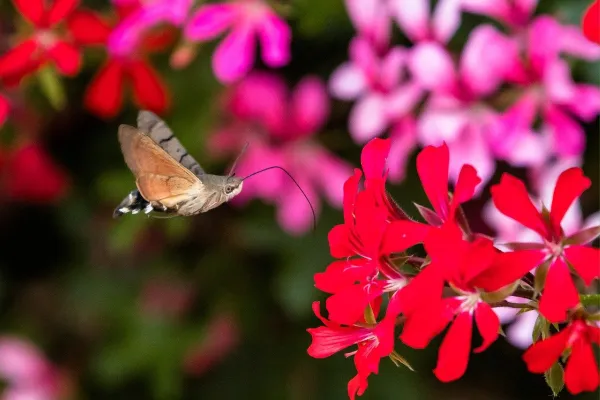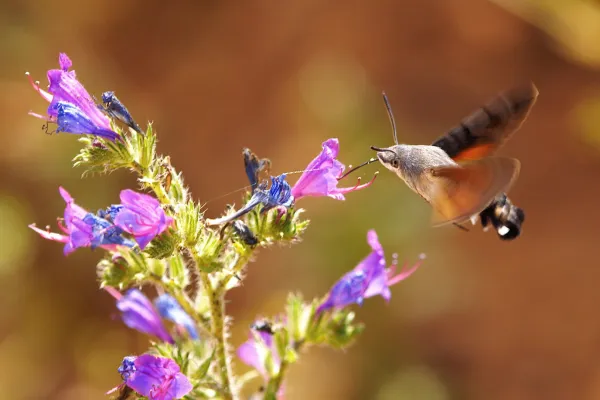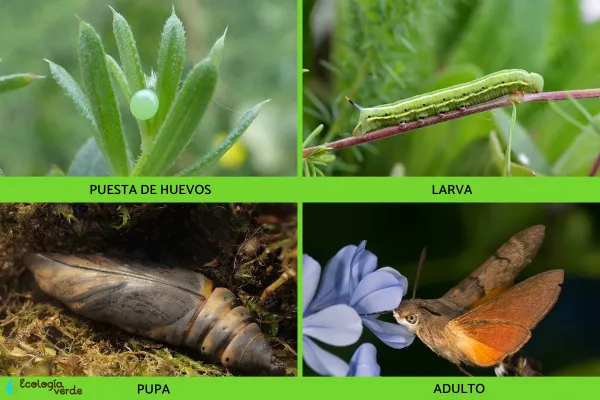Butterflies and moths never cease to amaze us with their dazzling colors and intricate patterns. But there is one insect that truly stands out—not just for its appearance, but because it looks and behaves remarkably like a hummingbird. With its vibrant wingbeats and hovering motion, the Hummingbird Sphinx is often mistaken for a bird. In this article, you'll discover everything about this fascinating insect: its features, habitat, diet, life cycle, reproduction, and behavior.

At first glance, the Hummingbird Sphinx (Macroglossum stellatarum) looks like a tiny bird. However, it’s actually a diurnal moth, meaning it’s active during the day. While many people refer to it as a “hummingbird butterfly,” it’s more accurately classified as a moth due to its behavior and anatomy.
Small and compact body: Typically very tiny in size.
Wingspan: Ranges from 3.4 to 5 centimeters.
Scaled body: Covered in fine scales that mimic the texture and pattern of bird feathers.
Two pairs of wings:
Forewings are grayish-brown with dark lines.
Hindwings are orange to yellowish.
Long proboscis (tongue): Nearly the same length as its body, coiled when at rest, used for feeding on nectar.
Johnston’s organ in the antennae: Helps stabilize its complex and agile flight.
Its appearance and movement have earned it the nickname “hummingbird hawk-moth,” a name it truly lives up to.
This species is native to the Old World—primarily Europe, Asia, and Africa—and its location changes with the seasons:
Spring/Summer: Migrates north to countries like Finland and other parts of Northern Europe.
Autumn/Winter: Moves south toward Southern Europe and Northern Africa.
It thrives at altitudes from sea level to 3,000 meters, showcasing remarkable adaptability to various climates and terrains.
As an adult, the hummingbird hawk-moth feeds exclusively on nectar using its long proboscis. Its rapid wingbeats—about 85 flaps per second—require a high-energy diet.
Prefers both wild and garden flowers.
Has a strong memory and will revisit known nectar sources.
Often found feeding in parks, gardens, and meadows.
Scabiosa
Galium (bedstraw)
Nicotiana (tobacco plants)
Viola (violets)
Rubia
Stellaria (chickweed)
Verbena
Jasminum (jasmine)
Primula (primrose)
Carduus (thistles)
Centaurea (knapweed)
Only adult moths feed on nectar. The caterpillar stage has a different diet, which we’ll explore next.

Like all insects that undergo complete metamorphosis, the Hummingbird Sphinx has four life stages: egg, larva (caterpillar), pupa, and adult.
Eggs:
Laid on host plants such as Asperula hirsuta and Galium spp.
Pale green in color.
Hatch after about 8 days.
Larva (Caterpillar):
Yellowish-green in early stages, grows up to 5 cm long.
Displays a sphinx-like pose with head down and rear up—hence the name “sphinx moth.”
Possesses 10 prolegs and a pointed tail horn that changes color from red to blue before pupation.
Feeds on the host plant’s leaves for about 20 days, depending on temperature.
Pupa:
Develops inside a loose cocoon, usually on the ground among leaves or stones.
Overwinters in this stage, without feeding.
Adult:
Emerges in spring with its distinctive hovering flight and humming sound.

Breeding takes place in spring. Once mating occurs, the female lays up to 200 eggs on suitable host plants. Depending on environmental conditions, the species can produce up to three generations per year.
This moth has several unusual traits compared to other moths:
Diurnal activity: Active during daylight, from dawn to dusk.
Can fly in light rain—a rare trait among moths.
Migratory: Avoids cold weather by moving to warmer regions in winter.
Hibernation: Hides in crevices, rocks, or man-made shelters during cold months.
Even in winter, if the temperature rises slightly, it may emerge briefly to feed and replenish energy.
Can hover in place while feeding, just like hummingbirds.
Wingbeat sounds are nearly identical to a hummingbird's hum.
Flight speed can reach up to 60 km/h.
No. The hummingbird hawk-moth poses no threat to humans. It does not bite or sting, and it doesn’t harm plants—it only feeds on nectar using a specialized proboscis.
The Hummingbird Sphinx is a shining example of nature’s mimicry and adaptation. With its hummingbird-like appearance and behavior, it captures the curiosity of nature lovers, scientists, and photographers alike. Despite being a moth, it thrives in daylight, migrates across continents, and plays a key role as a pollinator.
If you ever spot a humming creature hovering around flowers in your garden, don’t be too quick to call it a bird—it might just be the fascinating Hummingbird Sphinx in action.
Bibliography
Marco, L. R., & Tomás, A. A. (1989). Sphingids from the southwest of the province of Albacete. Al-Basit: Journal of Albacete Studies, (25), 121-139.
Moreno-Benítez, J. M. (2016). Distribution of the hummingbird sphinx Macroglossum stellatarum (Linnaeus, 1758) in the province of Málaga (Spain) (Lepidoptera: Bombycoidea: Sphingidae). Cádiz Journal of Entomology, 7(1), 335-350.
animal tags: Hummingbird Sphinx
We created this article in conjunction with AI technology, then made sure it was fact-checked and edited by a Animals Top editor.